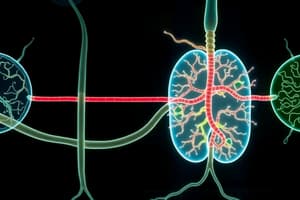Podcast
Questions and Answers
What does fermentation allow?
What does fermentation allow?
Glycolysis to continue producing ATP in the cytosol.
Why does fermentation occur?
Why does fermentation occur?
To support cellular respiration.
When does fermentation occur?
When does fermentation occur?
When oxygen levels are insufficient.
Where does fermentation occur?
Where does fermentation occur?
What are the reactants of lactic acid fermentation?
What are the reactants of lactic acid fermentation?
What are the products of lactic acid fermentation?
What are the products of lactic acid fermentation?
What are the reactants of ethanol fermentation?
What are the reactants of ethanol fermentation?
What are the products of ethanol fermentation?
What are the products of ethanol fermentation?
_________ enables cells to use glycolysis to produce ATP under anaerobic conditions.
_________ enables cells to use glycolysis to produce ATP under anaerobic conditions.
_______ conditions have low oxygen or no O2.
_______ conditions have low oxygen or no O2.
Cells can still make a small amount of ATP without _____ present.
Cells can still make a small amount of ATP without _____ present.
Fermentation converts NADH to ____.
Fermentation converts NADH to ____.
What is the enzyme that converts NAD+ to NADH?
What is the enzyme that converts NAD+ to NADH?
What enzyme converts NADH to NAD+?
What enzyme converts NADH to NAD+?
____ is a substrate for the glycolysis enzyme triose phosphate dehydrogenase.
____ is a substrate for the glycolysis enzyme triose phosphate dehydrogenase.
What kind of fermentation do human cells require?
What kind of fermentation do human cells require?
What are the functions of lactic acid fermentation?
What are the functions of lactic acid fermentation?
What are the products of lactic acid fermentation?
What are the products of lactic acid fermentation?
__________ is the process in baker's and brewer's yeast that enables glycolysis to produce ATP under anaerobic conditions.
__________ is the process in baker's and brewer's yeast that enables glycolysis to produce ATP under anaerobic conditions.
Alcohol fermentation produces _______ and ___.
Alcohol fermentation produces _______ and ___.
What are the two enzymes that drive alcohol fermentation?
What are the two enzymes that drive alcohol fermentation?
Pyruvate decarboxylase converts pyruvate from glycolysis to _________.
Pyruvate decarboxylase converts pyruvate from glycolysis to _________.
Alcohol dehydrogenase converts the carbohydrates produced in the first step to ______.
Alcohol dehydrogenase converts the carbohydrates produced in the first step to ______.
What organisms use alcohol fermentation?
What organisms use alcohol fermentation?
Our ancestors used ________ to produce important foods and safe water supplies.
Our ancestors used ________ to produce important foods and safe water supplies.
______ kills many pathogenic microbes that can contaminate water supplies.
______ kills many pathogenic microbes that can contaminate water supplies.
Flashcards are hidden until you start studying
Study Notes
Fermentation Overview
- Fermentation enables glycolysis to produce ATP by regenerating NAD+ in the cytosol.
- It occurs to support cellular respiration, especially when oxygen is insufficient.
Conditions and Location
- Fermentation happens in anaerobic conditions, defined by low or absent oxygen levels.
- The process takes place in the cytosol of cells.
Types of Fermentation
Lactic Acid Fermentation
- Reactants: Pyruvate and NADH.
- Products: Lactate and NAD+.
- Allows cells to continue ATP production through glycolysis under anaerobic conditions.
- Captures around 2.5-3.5% of the energy stored in glucose.
- Human cells primarily perform lactic acid fermentation.
Ethanol Fermentation
- Reactants: Pyruvate and NADH.
- Products: Ethanol, CO2, and NAD+.
- Facilitated by baker's and brewer's yeast.
- Alcohol fermentation involves two key enzymes: alcohol dehydrogenase and pyruvate decarboxylase.
- Converts pyruvate to acetaldehyde and then to ethanol.
Energy Production and Enzyme Functions
- Fermentation allows a small amount of ATP to be produced without oxygen.
- NAD+ is required for glycolysis to occur and produce ATP, transferred from NADH during fermentation.
- Enzymes like triose phosphate dehydrogenase convert NAD+ to NADH, while lactate dehydrogenase converts NADH back to NAD+.
Historical and Practical Significance
- Alcohol fermentation has been utilized since ancient times for food production and safe water supplies.
- Ethanol acts as a microbial agent, killing pathogens in water.
False Statements
- Fermentation does not allow cells to make ATP under aerobic conditions.
- Human cells do not perform alcohol fermentation; instead, they rely on lactic acid fermentation.
- Alcohol fermentation is beneficial for yeast survival in fluctuating oxygen environments.
Lactic Acid Fermentation Products
- Produces lactate, NAD+, CO2, and two molecules of ATP per glucose molecule.
Summary of Key Points
- Fermentation is crucial for ATP production when oxygen is low.
- Different pathways (lactic acid vs. ethanol) cater to various organisms and conditions.
- Both types of fermentation have significant historical and current implications for food production and safety.
Studying That Suits You
Use AI to generate personalized quizzes and flashcards to suit your learning preferences.




